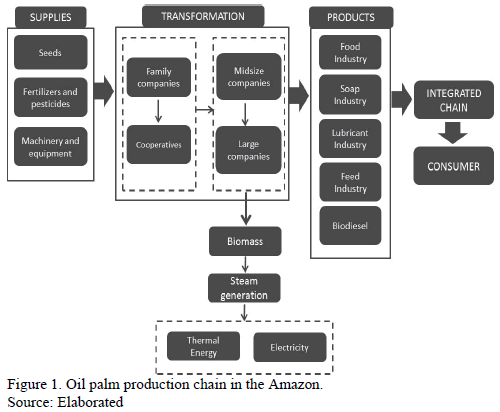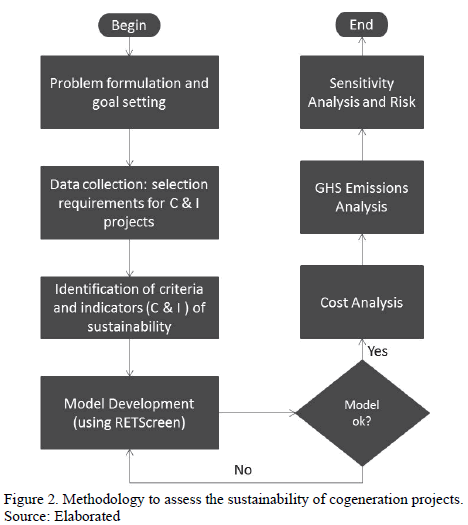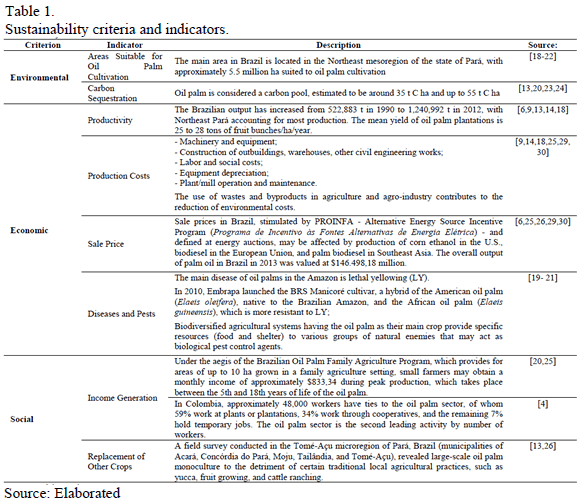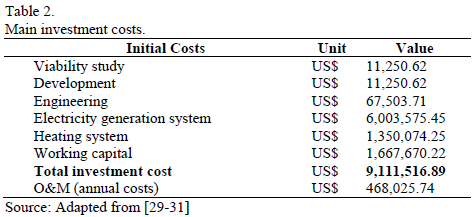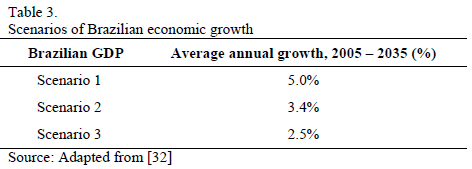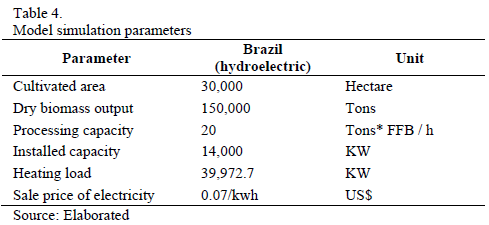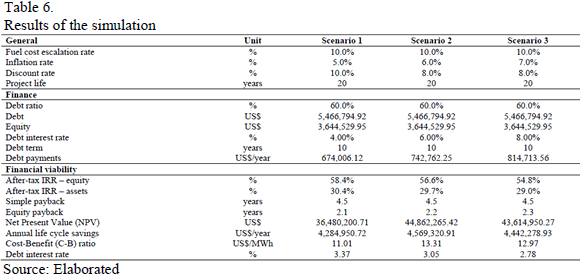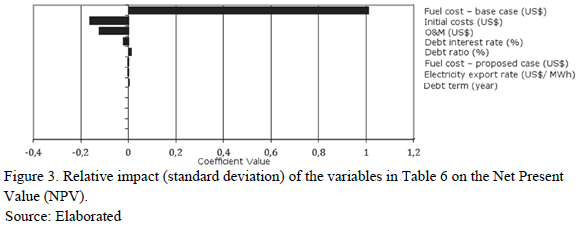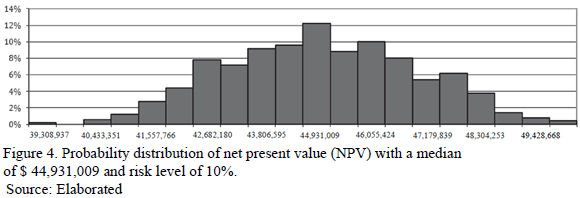Servicios Personalizados
Revista
Articulo
Indicadores
-
 Citado por SciELO
Citado por SciELO -
 Accesos
Accesos
Links relacionados
-
 Citado por Google
Citado por Google -
 Similares en
SciELO
Similares en
SciELO -
 Similares en Google
Similares en Google
Compartir
DYNA
versión impresa ISSN 0012-7353
Dyna rev.fac.nac.minas vol.82 no.190 Medellín mar./abr. 2015
https://doi.org/10.15446/dyna.v82n190.43298
DOI: http://dx.doi.org/10.15446/dyna.v82n190.43298
A methodology for analysis of cogeneration projects using oil palm biomass wastes as an energy source in the Amazon
Una metodología para el análisis de proyectos de cogeneración utilizando residuos de biomasa de palma de aceite como fuente de energía en la Amazonia
Rosana Cavalcante de Oliveira a, Rogério Diogne de Souza e Silva b & Maria Emilia de Lima Tostes c
a Brazilian Agricultural Research Corporation - Embrapa, Brasilia, Brazil. rosana.oliveira@embrapa.br
b Federal University of Pará, Belém, Brazil. rogeriodss@ieee.org
c Federal University of Pará, Belém, Brazil. tostes@ufpa.br
Received: May 5th, de 2014. Received in revised form: September 30th, 2014. Accepted: October 21th, 2014
This work is licensed under a Creative Commons Attribution-NonCommercial-NoDerivatives 4.0 International License.
Abstract
In the search for strategies to mitigate climate change, the promotion of renewable energy is a major challenge worldwide, particularly for developing countries such as Brazil and Colombia, which aim to diversify their power grids by using unconventional renewable energy sources. One of the main obstacles is the development of innovative projects. Increasing oil palm cultivation in the Amazon region for the food and biodiesel industries is producing a large volume of biomass. The present study outlines a methodology for analysis of renewable energy projects based on identification of environmental, economic, and social sustainability criteria and indicators (C&I) for the oil palm production chain. This methodology was then used to develop a computer simulation model in the RETScreen® International software environment for financial viability and risk analysis.
Keywords: Simulation; Biomass; Electricity generation; Palm oil; Sustainability; Amazon.
Resumen
La promoción de energías renovables como estrategia para mitigar las alteraciones climáticas es un gran desafío mundial, principalmente para países en vías de desarrollo como Brasil y Colombia, que buscan diversificar su matriz energética a partir de fuentes renovables no convencionales. Uno de los principales obstáculos para esta diversificación es la falta proyectos innovadores. La creciente producción de palma de aceite en la región amazónica para la generación de productos alimenticios y biodiesel está produciendo un gran volumen de biomasa. Este trabajo presenta una metodología de análisis de proyectos renovables, a partir de la identificación de los criterios e indicadores ambientales, económicos y sociales de sustentabilidad de la cadena productiva de la palma de aceite. A partir de la metodología, se desarrolló un modelo de simulación computacional, utilizando como herramienta el programa RETScreen® International para realizar los análisis de viabilidad económica y de riesgo.
Palabras clave: Simulación; Biomasa; Generación de electricidad; Aceite de palma; Sustentabilidad, Amazonía.
1. Introduction
Energy is one of the basic infrastructure components required for human development. The development of a nation requires increasing amounts of energy. Sustainable economic growth entails both supply-side and demand-side action. An energy planning strategy that can reconcile increasing internal energy demands and reduction in the costs and impacts caused by various energy generation and utilization processes is required.
Energy planning consists of the undertaking of studies and analyses to ensure that energy generation and utilization projects are technically and financially viable. One energy planning problem is decision making under uncertainty. A variety of techniques can help to deal with uncertainty, such as scenario planning by means of computer simulation. Scenario planning bridges a gap in strategic information, facilitating the understanding of this complex sector by stakeholders and bringing benefit to clients, companies, organizations, and stakeholders themselves.
The need to increase energy supply and diversify the energy matrix without additional impact on the environment has encouraged the development of sustainable technologies. Among the sustainable technologies mature enough to be used commercially, only biomass uses modern technological processes with high efficiency and flexibility to supply energy for electricity production and to move the transportation sector [1]. Biomass is a renewable energy source that provides flexibility due to its wide range of applications and can be used in the production of several fuels [2].
The Amazon region is a major biomass producer. Among its biomass-yielding crops, one stands out: the African oil palm (Elaeis guineensis). An oleaginous palm species of African origin, it was introduced to Brazil circa the 16th century, as a result of the slave trade. Commercial-scale growing of the palm began in 1967, but by the late 1980s, there was no longer any political interest in funding palm oil production, and the allocation of funds to this activity was ceased [3]. In 2010, the federal government resumed its investment in policies to support palm oil production, through the Sustainable Palm Oil Production Program (Programa de Produção Sustentável de Óleo de Palma) and the Low-Carbon Agriculture (Agricultura de Baixo Carbono, ABC) Program, which support the crop husbandry of oil palm groves, predominantly in degraded land.
In Colombia, the commercial cultivation of oil palms began in 1945 and has experienced sustained growth ever since. By 2010, there were over 400,000 ha of cultivated lands across 108 municipalities, up from 18,000 ha in the mid-1960s [4]. Colombia is currently the 5th leading producer of palm oil, accounting for 2% of the worldwide output.
According to the U.S. Department of Agriculture (USDA) [5], Indonesia is the world's leading producer of palm oil, with an output of 28.5 million tons in 2012/2013, followed by Malaysia with 19.32 million tons. Brazil, which had no palm oil output of any significance only 4 years ago, had risen to no. 10 on the world ranking by 2012/2013. According to the Brazilian Institute of Geography and Statistics (Instituto Brasileiro de Geografia e Estatística, IBGE) [6], in the year 2012, Brazil had a total output of 1,240,992 tons of fresh fruit bunches (FFB), worth $153.474,29 million. The state of Pará is the country's top producer, with an output of 1,034,361 tons FFB in 2012 [6]. Specifically, the Northeast Pará (Nordeste Paraense) mesoregion has the appropriate soil and climate factors for cultivation and accounts for the largest output.
Palm oil extraction produces biomass wastes, which can be used to generate power. The biomass produced in the state of Pará in 2012 could have generated 546,137 MWh/year. Companies involved in palm oil production intend to double their output by 2018. Hence, the potential for power generation from palm oil biomass wastes will also tend to double by 2018.
According to Duarte et al. [7], of all the potential renewable energy sources available in the Amazon region, palm oil biomass unquestionably has the greatest potential for electrical power generation. Biomass is expected to play an increasingly significant role in the "greening" of energy supply. However, concerns are rising as to the sustainability of large-scale energy crop production [8].
The electricity produced during the process can be used by the industry itself, with any surplus sold to the local distribution network operator through electricity auctions coordinated by the Brazilian Electricity Regulatory Agency (Agência Nacional de Energia Elétrica, ANEEL). According to Bazmi et al. [9], decentralized power generation from biomass could be an alternative for communities in remote areas, and could help transform the local economy and the activities and lifestyle of local populations. Fig. 1 shows a proposal developed by the authors to provide an overview of the oil palm production chain in the Amazon, highlighting the use of biomass wastes for thermal energy and/or electricity generation.
The present study proposes a methodology for energy efficiency analysis of oil palm biomass-fired power plant projects, aiming to contribute to the sustainable development of the Amazon.
2. Computer-based simulation as a tool for decision-making under uncertainty
2.1. Development of the research problem and definition of the research objective
According to Schubert [10], the circumstances that prevail in decision-making can be divided into three categories: certainty, uncertainty, and risk. The difference between uncertainty and risk depends on whether the probability of a given outcome is known (risk) or unknown (uncertainty).
Risk can be defined as an uncertainty that has been identified, prioritized, and quantified. On 14 February 2014, the Brazilian Minister for Mines and Energy, Edison Lobão, recognized the existence of a risk of power outages in Brazil in the event of "absolutely adverse" climate conditions. The Brazilian energy matrix is 81.9% hydroelectric [11], which makes it largely renewable, but susceptible to rationing and outages during droughts.
In Brazil, thermal power stations are usually activated only when hydroelectric reservoir levels are low. However, at least between October and December of the past two years, the country has been forced to activate all available thermal plants to meet power demands and help recover reservoir levels. This reveals a massive demand for thermal power stations to supply the national grid (Sistema Integrado Nacional, SIN). The sale of energy on the so-called Free Contracting Environment (Ambiente de Contratação Livre, ACL) takes place through auctions, where the winner is defined as the seller offering the lowest rate. According to the Ministry of Mines and Energy [12], of all electricity traded at auction from 2005 to 2013, 44.74% originated from hydroelectric sources and 24.76% from coal-fired or diesel-fired thermal power stations. In other words, the Brazilian energy matrix is becoming less renewable.
On the basis of this scenario, we defined the following research problem: can computer simulation be used as a decision support tool for energy planning by means of energy efficiency project analysis?
From this research problem, we then defined the following objectives:
First, to develop a methodology for the analysis of cogeneration projects; to collect data in the field and in the literature to identify the main sustainability criteria and indicators (C&I); to develop the model in the RETScreen® International software environment; and to analyze the proposed model, including cost analysis, greenhouse gas (GHG) analysis, sensitivity analysis, and risk analysis.
2.2. Development of methodology and data collection
The World Commission on Environment and Development, in 1987, defined sustainability or sustainable development as "forms of progress that meet the needs of the present without compromising the ability of future generations to meet their needs." The methodology developed considers criteria and indicators of sustainability in building a computer simulation model resulting in scenarios to support decision making in energy planning. The computer simulation development was carried out in the RETScreen® software suite. This paper applied the methodology proposal to analyze the potential using of oil palm biomass wastes as energy through a case study at a municipality Northeast of Pará that shows great expression of palm oil production.
The methodology was based on the work of Kurka and Blackwood [13], who presented a generic approach for the selection of sustainability criteria and indicators (C&I) using a participative methodology. We considered the work of Evans et al. [14], which identified the price of producing electricity, the efficiency of energy conversion, total carbon dioxide emissions, availability, limitations, water use, and social issues as key indicators of sustainability, and the principles of the Roundtable on Sustainable Palm Oil (RSPO) [15], a nonprofit organization that standardizes C&I for sustainable palm oil production from an economic, social, and environmental standpoint.
The methodology developed is shown in Fig. 2 and began by formulating a research problem to originate research objectives. The results of this stage were shown in section 2.1. For the data collection step, we identified selection requirements of projects by means of a review of the literature and field survey. The main sources consulted in the data collection stage can be seen in Table 1. For our field survey, we visited a series of farms in the Tomé-Açu microregion and interviewed stakeholders, namely small and medium farmers and experts in the area.
The sustainability C&I identified in the next step of the methodology, from data collection, notes the concept of triple bottom line. The C&I were clustered into three categories: environmental, economic and social, by analyzing the scenario of cogeneration in the Amazon. They reflect the main questions of the stakeholders and can be used both to measure and to report on the sustainability of projects or progress of sustainable development. Table 1 lists the sustainability C&I identified.
Simulation is a powerful tool for the development of more efficient systems and to support decision making [16]. Simulation consists of an experimentation process based on the development of a model that replicates the workings of a real or idealized system to determine how this system will respond to changes in structure, environment, or surrounding conditions [17]. A model is a representation of a real system containing the information necessary for the purposes of simulation. The Model development step was carried out in the RETScreen® software suite. The energy model will be described in greater detail in section 2.3, the Cost Analysis, GHS Emissions Analysis and Sensitivity Analysis and Risk will be described in section 2.4
2.3. Model development
Despite the potential for electricity generation from oil palm biomass wastes, according to ANEEL [27], as of 2013, only two agro-industrial operations used this renewable fuel source in the state of Pará: Indústria Palmares, with a 1,640-kW plant, and Agropalma, with a 2,710.40-kW plant.
Seeking to assess the sustainability of combined heat and power (CHP) cogeneration from oil palm biomass wastes in Northeast Pará, this section presents the development of a cogeneration model to evaluate the technical, economic, environmental, and social viability of the implementation of such a plant in three different scenarios.
A scenario is a prospective study of the future combined with an organization of obtained information so as to provide a coherent, systematic, comprehensive, and plausible story, with the purpose of describing a given event, instructing and supporting decision making [28].
This case study considered a 14-MW thermal power plant operating 24 hours a day, 365 days a year, and requiring 0.85 tons of dry biomass wastes per megawatt-hour (MWh) generated. The sale price was set at US$65.91/MWh, which is the average price at electricity auctions [12]. The project is located in the municipality of Thailand because it produced 33% of palm oil produced in Brazil in 2012, and as emphasized in the economic criterion, production costs indicator, the use of wastes and byproducts in agriculture contributes to the reduction of costs.
Considering the economic sustainability C&I identified, using Favaro [29], Oddone [30], and Monteiro [31], as well as current market parameters as sources for acquisition of the 14-MW plant and cogeneration equipment, Table 2 shows the main initial investment costs, including operation and maintenance (O&M) costs, which cover parts and labor for 12 months of operation.
Three economic growth scenarios were simulated for the Amazon region, using as a basis the scenarios presented in the National Energy Plan - 2030 devised by Empresa de Pesquisa Energética (EPE). Table 3 provides an overview of macroeconomic outcomes in Brazil for the 2005-2035 period in each of the scenarios.
Scenario 1: optimistic scenario, which presumes that current trends in international integration will remain and advances will be made on measures that will speed up the process of convergence of the Brazilian economy toward developed-nation standards.
Scenario 2: less favorable scenario regarding the world economy. The Brazilian economy will grow at rates similar to or just below the world average.
Scenario 3: pessimistic scenario. The world economy will exhibit little growth or even a retraction, with growth rates similar to those now seen in developed nations, and Brazil will continue its participatory role in the world economy.
Model data
- Project location: Tailândia;
- Seasonal efficiency: oil palm is productive year-round. For the purposes of the model, peak yield was defined as occurring between years 7 and 12;
- Other model data are shown in Table 4
2.4. Analysis of energy efficiency project
On environmental analysis, we compared the performance of oil palm biomass-fired thermal power stations to that of coal- and diesel-fired plants and to the national grid (SIN), which is predominantly hydroelectric.
Regarding the environmental aspects of the project, considering line losses of 5%, Table 5 presents a comparison of greenhouse gas (GHG) emissions by energy source. The crude annual reduction in GHG emissions is in relation to biomass.
Regarding the financial viability of the project, Table 6 provides a comparison of the three scenarios, taking into account different inputs for the following variables: inflation rate, discount rate, and debt interest rate.
Financial viability analysis revealed an internal rate of return (IRR) of 29% in the pessimistic scenario and 30.4% in the optimistic scenario - rates in excess of those provided by traditional investments such as the interbank certificate of deposit (CDI), which had a cumulative return of 18.5% over the last few years. In all three scenarios, the time to simple payback was 4.5 years, with a project life of 20 years.
The cost-benefit (C-B) ratio is an indicator of the benefits of a project. Once C-B ratios have been calculated for each project, the decision criterion consists of investing in the considered projects in decreasing merit order, i.e., from the lowest to the highest C-B ratio. Therefore, the C-B ratio (US$/MWh) of each generation project is defined as the ratio of its total cost to the energy benefit provided [33]. The amount of electricity that can be generated by biomass-fired power plants depends on the amount of biomass available during the harvest period - which, for the oil palm, occurs year-round - and on the conversion coefficient of each machine.
In the energy market, investment risk analysis is absolutely essential given the complexity of the market. According to ANEEL [27], the long-term balance between energy supply and demand depends on new energy supply and, therefore, on the decision to invest in expanding energy generation capabilities.
On sensitivity analysis of the variable "Net Present Value (NPV)" in scenario 2, varying the electricity export rate (i.e., the price of electricity exported to grid) over a 30% sensitivity range, the NPV ranged from US$44,848,228.7 when the electricity export rate was US$0.05/MWh to US$44,876,302.6 with an electricity export rate of US$0.09/MWh. In other words, even with variations in the energy market, the investment remains financially appealing. Fig. 3 shows, with a margin of ±10%, which variable had the greatest impact on performance analysis of Net Present Value (NPV). In this case, the variable is "Fuel cost - base case", which is the oil palm biomass waste that was previously discarded and is now reused by the company at no added cost. The variable with the greatest negative impact was the initial cost of investment. The results of the analysis of the other two scenarios were similar to those of scenario 2, i.e., the NPV of an oil palm biomass cogeneration plant is not too sensitive to minor variations in the financial scenario.
Fig. 4 shows, with a risk level of 10%, the probability distribution of the NPV variable yielded a confidence interval of US$41,892,761.8to US$48,265,011.93.
3. Conclusion
Regarding environmental and social sustainability, based on the C&I identified, oil palm has the potential to generate income with sustained and eco-friendly, clean production; protect soils from the effects of erosion and prevent land degradation; provide a high rate of carbon sequestration; and provide an option for reforestation of deforested areas. However, this only holds true if oil palm, which is considered a carbon sink, is being grown in previously deforested areas. If native forest areas are clear-cut to make way for oil palm monoculture, oil palm biomass will cease to be a sustainable energy source.
Regarding social impacts, we observed the development of new partnerships between companies, the State, and local elites for legitimization of the agro-industrial use of lands classified as "degraded", to the detriment of traditional communities. Therefore, socioeconomic analyses of this activity must consider the following aspects: a new order in land ownership relations; uncertainties as to land ownership; and contracts between companies and family farmers.
Once the viability of the use of oil palm biomass cogeneration systems has been demonstrated, the government may create public policies to encourage sustainable development practices, diversifying the energy matrices of Brazil and Colombia. Nevertheless, we recommend that additional protections be implemented for small farmers and traditional communities in the form of financial incentives and financial support.
References
[1] Cortez, L.A.B. e Lora, E.O.G., Biomassa para energia. Campinas, SP: Editora Unicamp, 2008. [ Links ]
[2] Rosillo-calle, F., Bajay, S.V. e Rothman, H., Uso da biomassa para a produção de energia na indústria brasileira. Campinas, SP: Unicamp, 2005. [ Links ]
[3] Santos, M.A.S., D'Ávila, J.L., Costa, R.M.Q., Costa, D.L.M., Rebello, F.K. e Lopes, M.L., O comportamento do mercado do óleo de palma no Brasil e na Amazônia Estudos Setoriais 11. Belém, Pará: BASA, 1998. [ Links ]
[4] García-Cáceres, R., Núñez-Moreno, A., Ramírez- Ortiz T and Jaimes-Suárez, S., Characterization of the upstream phase of the Colombian oil palm agribusiness value and supply chain, DYNA [on line], 80 (179), pp. 79-89, Jun, 2013. [date of reference January 20th of 2014]. Available at: http://www.scielo.org.co/pdf/dyna/v80n179/v80n179a09.pdf [ Links ]
[5] USDA., United States Department of Agriculture. [on line]. [date of reference January 10th of 2014]. Available at: http://apps.fas.usda.gov/psdonline/ [ Links ]
[6] IBGE., Instituto Brasileiro de Geografia e Estatística. [on line]. [date of reference January 10th of 2014]. Available at: http://www.sidra.ibge.gov.br/ [ Links ]
[7] Duarte, A.L.M., Bezerra, U.H., Tostes M.E.L. and Rocha, G.N.F., Alternative energy sources in the Amazon. Power and Energy Magazine, IEEE Journals & Magazines, 5 (1), pp. 51-57, 2007. DOI: 10.1109/MPAE.2007.264870 [ Links ]
[8] Buytaert, V., Muys, B., Devriendt, N., Pelkmans, L., Kretzschmar, J.G. and Samson, R., Towards integrated sustainability assessment for energetic use of biomass: A state of the art evaluation of assessment tools. Renewable and Sustainable Energy Reviews 15 88), pp. 3918-3933, 2011. DOI: 10.1016/j.rser.2011.07.036 [ Links ]
[9] Bazmi, A.A., Zahedi, G. and Hashim, H., Progress and challenges in utilization of palm oil biomass as fuel for decentralized electricity generation. Renewable and Sustainable Energy Reviews, 15 (1), pp. 574-583, 2011. DOI: 10.1016/j.rser.2010.09.031. [ Links ]
[10] Schubert, P., Análise de investimentos e taxa de retorno. São Paulo: Ática, 1989. [ Links ]
[11] BEN., Balanço Energético Nacional 2012: Ano base 2011 / Empresa de Pesquisa Energética. Rio de Janeiro: EPE, 2012. [ Links ]
[12] MME., Ministério de Minas e Energia. [on line]. Gestão da Comercialização de Energia - Leilões de Energia. [date of reference February 14th of 2014] Available at: http://www.mme.gov.br/mme/galerias/arquivos/acoes/Energia/Quadro_Leiloes_Boletim_Tarifxrio_1-14.pdf. [ Links ]
[13] Kurka, T. and Blackwood, D., Participatory selection of sustainability criteria and indicators for bioenergy developments. Renewable and Sustainable Energy Reviews 24, pp. 92-102, 2013. DOI: 10.1016/j.rser.2013.03.062 [ Links ]
[14] Evans, A., Strezov, V. and Evans, T.J., Sustainability considerations for electricity generation from biomass. Renewable and Sustainable Energy Reviews 14 (5), pp. 1419-1427, 2010. DOI: 10.1016/j.rser.2010.01.010 [ Links ]
[15] RSPO., Roundtable Sustainable Palm Oil. [on line]. [date of reference January 14th of 2014].Available at: http://www.rspo.org/. [ Links ]
[16] Saliby, E. and Medina, A., Modelagem e simulação de eventos discretos. Rio de Janeiro: COPPEAD/UFRJ, 2004. [ Links ]
[17] Harrell, C., Ghosh, B.K. and Bowden, R., Simulation using ProModel. Edition: 2, McGraw-Hill Professional, 2003. [ Links ]
[18] Lora, E.S. and Andrade, R.V., Biomass as energy source in Brazil. Renewable and Sustainable Energy Reviews 13 (4), pp. 777-788, 2009. DOI: 10.1016/j.rser.2007.12.004 [ Links ]
[19] Furlan, J.J., Biodiesel: Porque tem que ser dendê. Belém: EMBRAPA Amazônia Oriental, PALMASA, 2006. [ Links ]
[20] Kato, O.R., Vasconcelos, S.S., Capela, C.J., Miranda, I.S., Lemos, W.P., Maues, M.M., Azevedo, R., Castellan, D.C e Thom, G., Projeto Dendê em sistemas agroflorestais na agricultura familiar. In: congresso brasileiro de sistemas agroflorestais, 8, Belém, PA, [on line] 2011. [date of reference November 05th of 2013] Available at: http://www.alice.cnptia.embrapa.br/handle/dc/910652. [ Links ]
[21] Gan J.B. and Smith, C.T., A comparative analysis of woody biomass and coal for electricity generation under various CO2 emission reductions and taxes. Biomass Bioenergy 30 (4), pp. 296-303, 2006. DOI: 10.1016/j.biombioe.2005.07.006 [ Links ]
[22] Bastos, T.X., Muller, A.A., Pacheco, N.A., Sampaio, S.M.N., Assad, E.D. e Marques, A.F.S., Zoneamento de riscos climáticos para a cultura do dendezeiro no Estado do Pará. Revista Brasileira de Agrometeorologia, [on line]. 9 (3), pp. 564-570, 2001. [date of reference November 10th of 2013] Available at: http://www.alice.cnptia.embrapa.br/handle/doc/403766. [ Links ]
[23] Dornburg, V., Van Dam, J. and Faaij, A., Estimating GHG emission mitigation supply curves of large-scale biomass use on a country level. Biomass Bioenergy 31 (1), pp. 46-65, 2007. DOI: 10.1016/j.biombioe.2006.04.006 [ Links ]
[24] Yui, S. and Yeh, S., Land use change emissions from oil palm expansion in Pará, Brazil depend on proper policy enforcement on deforested lands. IOP Publishing Environmental Research Letters. Environ. Res. Lett. 8 (4) pp. 1-9, 2013. DOI: 10.1088/1748-9326/8/4/044031. [ Links ]
[25] Alves, S.A.O., Sustentabilidade da agroindústria de palma no Estado do Pará. PhD. Thesis, Department of forestry research, ESALQ/USP, Piracicaba, Brasil, 2011. [ Links ]
[26] Silva, F.L., Homma, A.K.O. and Pena, H.W.A., O cultivo do dendezeiro na Amazônia: promessa de um novo ciclo econômico na região. Observatorio de la Economía Latinoamericana, [on line]. 158, 2011. [date of reference December 10th of 2013]. Available at: http://www.alice.cnptia.embrapa.br/handle/doc/950874. [ Links ]
[27] ANEEL. Agência Nacional de Energia Elétrica. Banco de Informações de Geração - BIG. [on line]. [date of reference December 10th of 2013].Available at: http://www.aneel.gov.br/area.cfm?idArea=15. [ Links ]
[28] Coates, J.F., Scenario planning. Technological Forecasting and Social Change, 5, pp.115-123, 2000. [ Links ]
[29] Favaro, F.T., Desenvolvimento sustentável na Amazônia: Uma nova abordagem do dendê com o aproveitamento da biomassa residual para a geração de energia, MSc. Thesis, University of São Paulo, São Paulo, Brazil, 2011. [ Links ]
[30] Oddone, D.C., Cogeração: Uma Alternativa para Produção de Eletricidade, MSc. Thesis, University of São Paulo, São Paulo, Brazil, 2001. [ Links ]
[31] Monteiro, K.G., Análise de indicadores de sustentabilidade socioambiental em diferentes sistemas produtivos com palma de óleo no Estado do Pará, PhD. Thesis., Federal University of Rural Amazona, Belém, Brazil, 2013. [ Links ]
[32] Plano Nacional de Energia - PNE 2030, [on line]. [date of reference February 14th of 2014] Available at: http://www.epe.gov.br/Estudos/Paginas/Plano%20Nacional%20de%20Energia%20%E2%80%93%20PNE/Estudos_12.aspx?CategoriaID=346. [ Links ]
[33] EPE., Índice de Custo Benefício (ICB) de Empreendimentos de Geração Termelétrica, [on line]. 2011. [date of reference February 14th of 2014] Available: http://www.aneel.gov.br/aplicacoes/editais_geracao/documentos/ANEXO%20XIV%20-%20Metodologia%20do%20C%C3%A1lculo%20do%20%C3%8Dndice%20de%20Custo%20Benef%C3%ADcio%20-%20ICB.pdf. [ Links ]
R.C. de Oliveira, received a BSc Eng. in Production Engineering in 2005 from the University of State of Pará, Brasil, received a BSc Eng. in Computing Engineering in 2006 from the Federal University of Pará, Brasil, received the MSc in Operational Research in 2008 from the Federal University of Pernambuco, Brasil and a Sp degree in Mining and Metallurgical Systems in 2009 from the Federal University of Ouro Preto, Brasil. Professor at the University of Amazonia, 2008 to 2011. She was a professor at the Pará State University from 2010 to 2011. Currently, she is an analyst at the Brazilian Agricultural Research Corporation (Embrapa). Her research interests include: simulation, modeling and forecasting in energy markets; risk analysis and computational intelligence techniques; and optimization using metaheuristics. ORCID: https://orcid.org/0000-0003-0336-6780. CV: http://lattes.cnpq.br/8651693673302935
R.D.S. Silva, received a BSc Eng. and MSc in in Eletrical Engineering from the Federal University of Pará, Brasil, a MBA in Management and Environmental Technologies from University of São Paulo, Brasil. He is member of Industry Applications Society and Power and Energy Society do IEEE (Institute of Electrical and Electronics Engineers). Currently, he is a professor and researcher in the area of power systems, focusing on the theme Energy and the Environment. He teaches energy conversion, energy efficiency, and electricity applied, works in the development of solutions in energy efficiency, power quality and energy integrated planning. CV: http://lattes.cnpq.br/7704979218417437
M.E.L. Tostes, received a BSc Eng in Electrical and Computer in 1987 from the Federal University of Pará, Brasil, has a MSc in 1992,in Electrical Engineering from the Federal University of Pará, Brasil, and PhD in 2003, in Electrical Engineering from the Federal University of Pará, Brasil. She is currently Director of the Institute of Technology and associate professor I of the Federal University of Pará, Brasil. She has experience in electrical engineering with emphasis on power quality and energy efficiency. CV: http://lattes.cnpq.br/4197618044519148













